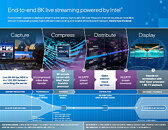
Intel's Global CPU Market Share is on the Rise, AMD Starts the Downfall
Since the launch of AMD's Ryzen processors, the CPU market share has been reshaped in AMD's favor. Intel's offerings were matched by team red, and AMD quickly broke into the consumer market. However, according to the latest round of reports, it seems like that is no longer the case. As per the Japanese DIY market analysis from BCNR, sales of Intel processors started rising in mid-2021, and the company is managing to grab some market share from AMD. After nearly two years of dominance in the Japanese market, AMD is now behind Intel in sales, and team blue is getting back to its older setting.
Another source that is generally a pretty good indicator of the market share of Intel and AMD processor is PassMark. As users submit their benchmark runs, the PassMark software developer has updated the CPU market share statistics chart, mainly showing the desktop segment. It also concludes the same thing as BCRN: Intel is again gaining share in the CPU market. As it always goes hand-in-hand, AMD is losing the CPU marker share naturally. This is due to many reasons, and it seems like Intel's marketing and supply tactics are paying off. Intel now sits at 60% share, while AMD is set at 40%.
Another source that is generally a pretty good indicator of the market share of Intel and AMD processor is PassMark. As users submit their benchmark runs, the PassMark software developer has updated the CPU market share statistics chart, mainly showing the desktop segment. It also concludes the same thing as BCRN: Intel is again gaining share in the CPU market. As it always goes hand-in-hand, AMD is losing the CPU marker share naturally. This is due to many reasons, and it seems like Intel's marketing and supply tactics are paying off. Intel now sits at 60% share, while AMD is set at 40%.















































